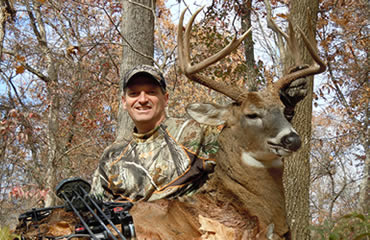Tracking wounded deer is a skill you can improve with practice.
I enjoy tracking deer. It's not as fun when a deer you've shot presents a difficult trail, but I've become a much better tracker by volunteering to help track others' bucks. With less anxiety involved in tracking for someone else, you're free to keep calm and learn more from the experience.
The most important aspect to solving a difficult track is patience. In most cases, there is no need to rush while trailing a wounded deer.
The first step is to establish where the deer was standing at the moment of impact. If you're helping someone else, listen to the hunter's tale of how the shot happened. That said, never assume the hunter saw what he thinks he saw.
That's not criticism. Upon arriving to track one of my best archery bucks the following morning, I mistakenly had everyone in the party looking a solid 50 yards from where the buck actually ran. Long story short, I could have saved us all a few hours of futile hiking if I had started in the correct spot. The lesson is you can't always trust your senses when you're completely frazzled on adrenaline and buck fever.
Once you find the track, go slow. I often sit crouched next to the trail as other trackers race off. One of my pet peeves is people who walk on the very trail they're trying to track. Stay off to the side of the blood trail, because you'll often have to come back to the last spot of blood to reorient. There's a good chance you'll walk on sign if you stay directly in line with the blood.
While crouched next to the last blood, look ahead 5 or 10 yards for the next spot. That's not always possible on light trails or when tracking by flashlight, but try it before leaving to look elsewhere.
Mark blood spots with toilet tissue so it dissolves after a day or two. If you'll be leaving the woods to return later, use flagging ribbon on the last few spots. You'll want to mark more than one spot to establish the deer's general direction of travel. Rarely have I seen a deer make sharp turns, and you'll almost always find the next blood somewhat in line with previous drops.
Resist the temptation to walk greater distances ahead to look for sign. If there are other people helping, someone else will do that. Be the one who stays on the known sign and plug away foot-by-foot if necessary.
I would love to be able to tell you exactly when to call off a track, but every situation is different. My inclination is to stick with it as long as there is sign to find. The exception is when you actually bump the deer and know it is still able to run.
Lastly is a note about when to begin tracking. That's not so much an issue during firearms season, but it's a big question when bowhunting. You have to balance the risk of losing the deer with losing the meat. You have an exponentially better chance of finding your bow buck if you quietly sneak out of the woods without any tracking and return the next morning (for deer shot in the evening, obviously). That said, if temperatures are going to remain in the 50s or 60s overnight, the meat can spoil.
Keeping in mind my earlier note about not always trusting your senses, make your best judgment about the shot. If you're confident it was a lethal hit, wait an hour or so and begin tracking. If you know you didn't hit your mark, or if you have doubts, it's usually best to wait until morning.
Read Recent Tip of the Week:• Feelin' Squirrely: Annual event reminds us that shooting is a year-round activity. And, it's FUN!




.png)